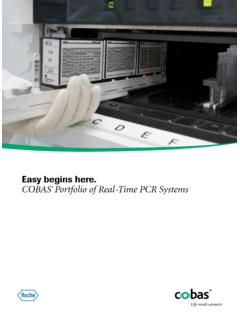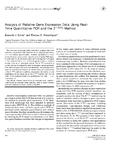Transcription of Real-Time PCR Vs. Traditional PCR - Applied …
1 For Reference OnlyPage 1 of 15 Real-Time PCR Vs. Traditional PCRD escriptionThis tutorial will discuss the evolution of Traditional PCR methods towardsthe use of Real-Time chemistry and instrumentation for tutorial will provide an understanding of the following: Limitations of Traditional PCR Introduction to Real-Time PCR Advantages of Real-Time chemistries over Traditional PCRmethodsFor Reference OnlyPage 2 of 15 The Evolution of PCR to real -TimePCR has completely revolutionized the detection of RNA and PCR has advanced from detection at the end-point of thereaction to detection while the reaction is occurring.
2 Figure 1: Real-Time PCR EvolutionDNA ExtractionPCRReal TimeDetectionReal- time Vs Traditional PCRReal- time chemistries allow for the detection of PCR amplification duringthe early phases of the reaction. Measuring the kinetics of the reaction inthe early phases of PCR provides a distinct advantage over traditionalPCR detection. Traditional methods use Agarose gels for detection ofPCR amplification at the final phase or end-point of the PCR Reference OnlyPage 3 of 15 Limitations of End-Point PCRA garose gel results are obtained from the end point of the reaction.
3 End-point detection is very time consuming. Results may not be obtained fordays. Results are based on size discrimination, which may not be veryprecise. As seen later in the section, the end point is variable fromsample to sample. While gels may not be able to resolve thesevariabilities in yield, Real-Time PCR is sensitive enough to detect thesechanges. Agarose Gel resolution is very poor, about 10 fold. real -TimePCR can detect as little as a two-fold change!Some of the problems with End-Point Detection: Poor Precision Low sensitivity Short dynamic range < 2 logs Low resolution Non - Automated Size-based discrimination only Results are not expressed as numbers Ethidium bromide for staining is not very quantitative Post PCR processingFigure 2: Agarose GelAs you can see from the figure, the samples in the gel contain 10 copiesand 50 copies, respectively.
4 It is hard to differentiate between the 5-foldchange on the Agarose gel. Real-Time PCR is able detect a two-foldchange ( 10 Vs. 20 copies).10 copy50 copyFor Reference OnlyPage 4 of 15 PCR Phases:To understand why end-point PCR is limiting, it is important to understandwhat happens during a PCR basic PCR run can be broken up into three phases: Exponential: Exact doubling of product is accumulating atevery cycle (assuming 100% reaction efficiency). Thereaction is very specific and precise. Linear (High Variability): The reaction components arebeing consumed, the reaction is slowing, and products arestarting to degrade.
5 Plateau (End-Point: Gel detection for traditionalmethods): The reaction has stopped, no more productsare being made and if left long enough, the PCR productswill begin to 3: PCR PhasesFigure 3 shows three replicates of a sample. The replicates have thesame starting quantity. As the PCR reaction progresses, the samplesbegin to amplify in a very precise manner. Amplification occursexponentially, that is a doubling of product (amplicon) occurs every type of amplification occurs in the exponential phase.
6 Exponentialamplification occurs because all of the reagents are fresh and available,the kinetics of the reaction push the reaction to favor doubling [DNA]Cycle #ExponentialPPllaatteeaauuLLiinneeaarrEt hidium-GeldetectionVariable yieldFor Reference OnlyPage 5 of 15 However, as the reaction progresses, some of the reagents are being consumedas a result of amplification. This depletion will occur at different rates for eachreplicate. The reactions start to slow down and the PCR product is no longerbeing doubled at each cycle.
7 This linear amplification can be seen in the linearphase of the reaction. The three samples begin to diverge in their quantitiesduring the linear phase. Eventually the reactions begin to slow down and stop all together or tube or reaction will plateau at a different point, due to the different reactionkinetics for each sample. These differences can be seen in the plateau plateau phase is where Traditional PCR takes its measurement, also knownas end-point 3 also shows that the three replicate samples, which started out at thesame quantity in the beginning of the reaction, reflect different quantities at theplateau phase.
8 Since the samples are replicates they should have identicalquantities. Therefore, it will be more precise to take measurements during theexponential phase, where the replicate samples are amplifying exponentially. The amplification phases can be viewed differently to assess the PCR figures that follow show the phases of PCR in a Logarithmic scale view anda Linear scale view (Figures 4 and 5). Applied Biosystems Sequence DetectionSystem Instruments can view the data in both Reference OnlyPage 6 of 15 Problems with detection in the Plateau phase of PCRThe following three figures show the plateau affect on 96 replicates and a five-fold dilution series.
9 As stated earlier, the plateau region is the end-point of thereaction and is representative of the amount of product that you would see onAgarose Gels. The 96 replicates in the exponential phase are very tight in boththe linear and logarithmic views. In the logarithmic view, Figure 7, the plateau for each reaction seems to occur inthe same place, but this is solely due to the log scaling of the plot. Figure 6shows the same 96 replicates in linear view. The reactions show a clearseparation in the plateau phase.
10 Therefore, if the measurements were taken inthe plateau phase, quantitation would be 6: Linear view 96 replicatesFigure 7:Log view 96 replicates Plateau effect ExponentialPhaseExponentialPhasecyclesEx ponential Phase Plateau effectRnFor Reference OnlyPage 7 of 15 Figure 8: Log view 5-fold dilution seriesThe 5-fold dilution series, seen in Figure 8, seems to plateau at the same placeeven though the exponential phase clearly shows a difference between thepoints along the dilution series. This reinforces the fact that if measurementswere taken at the plateau phase, the data would not truly represent the initialamounts of starting target chemistry provides fast, precise and accurate results.





